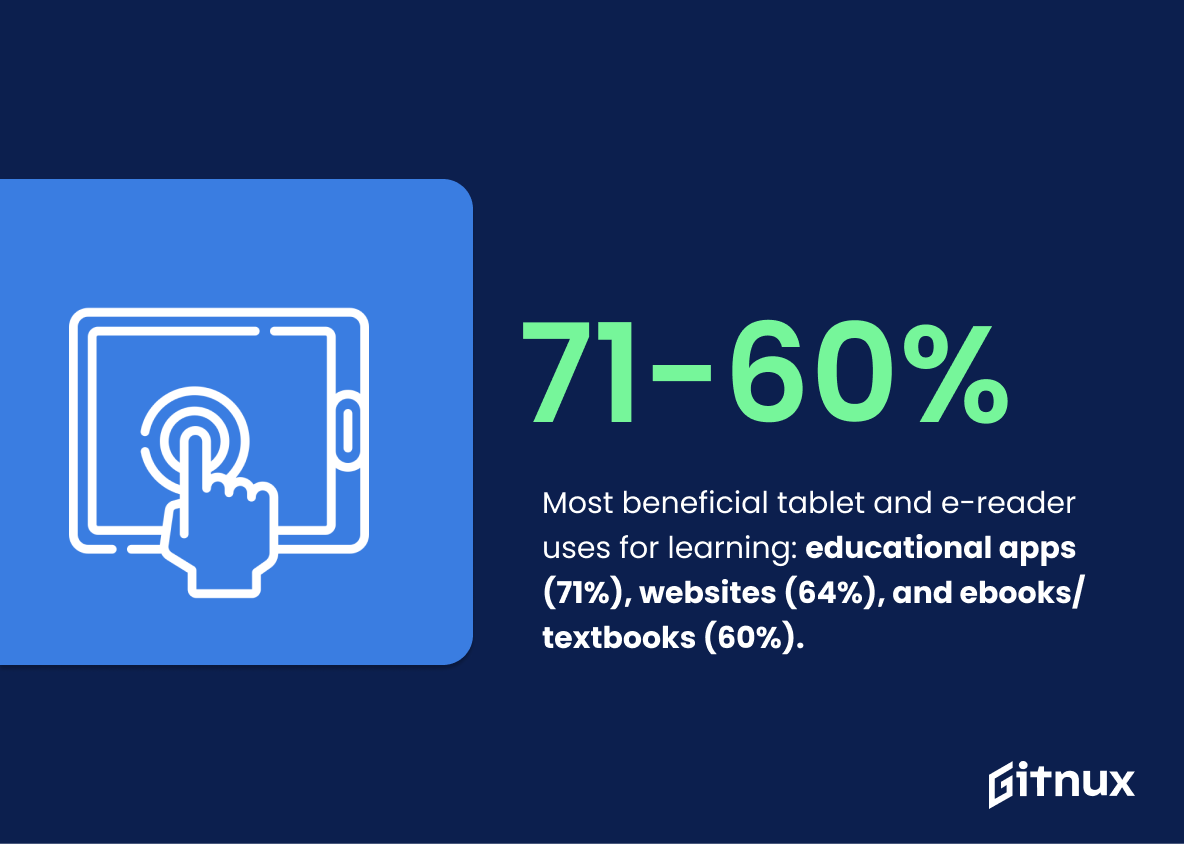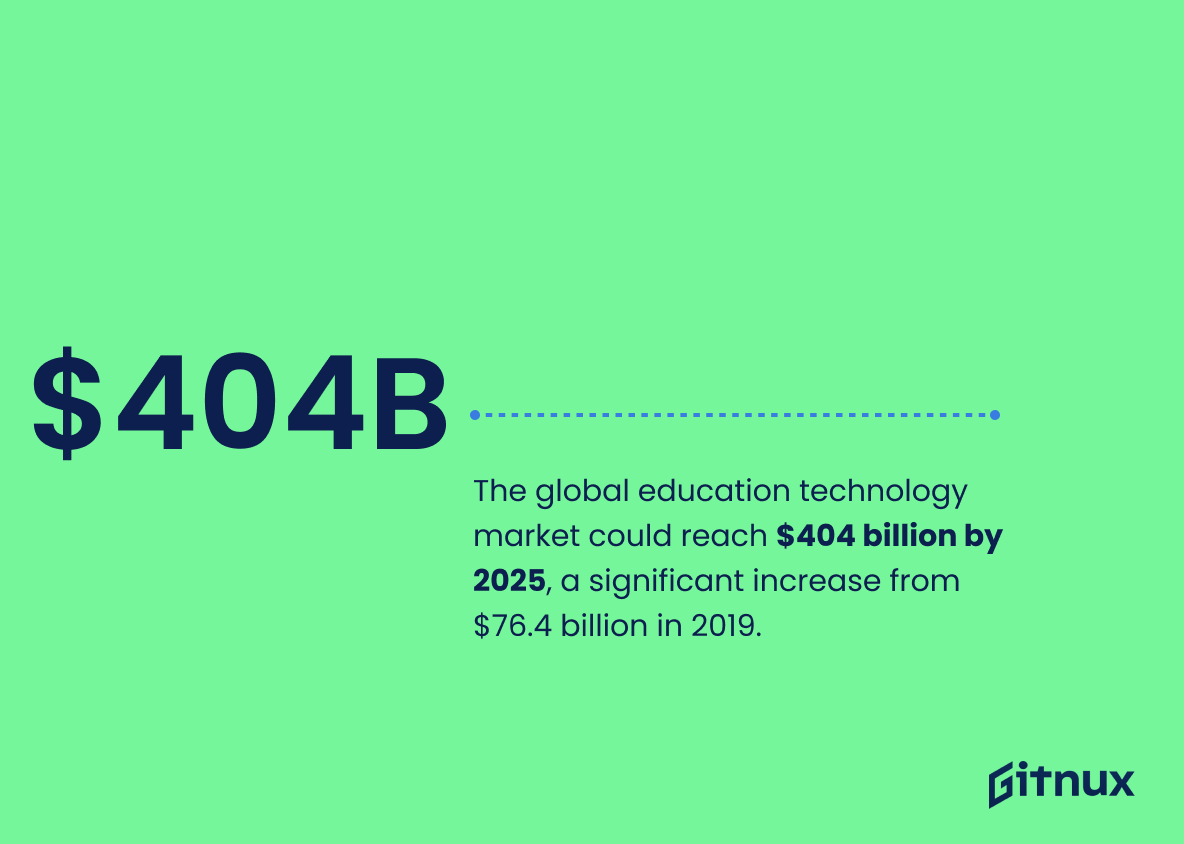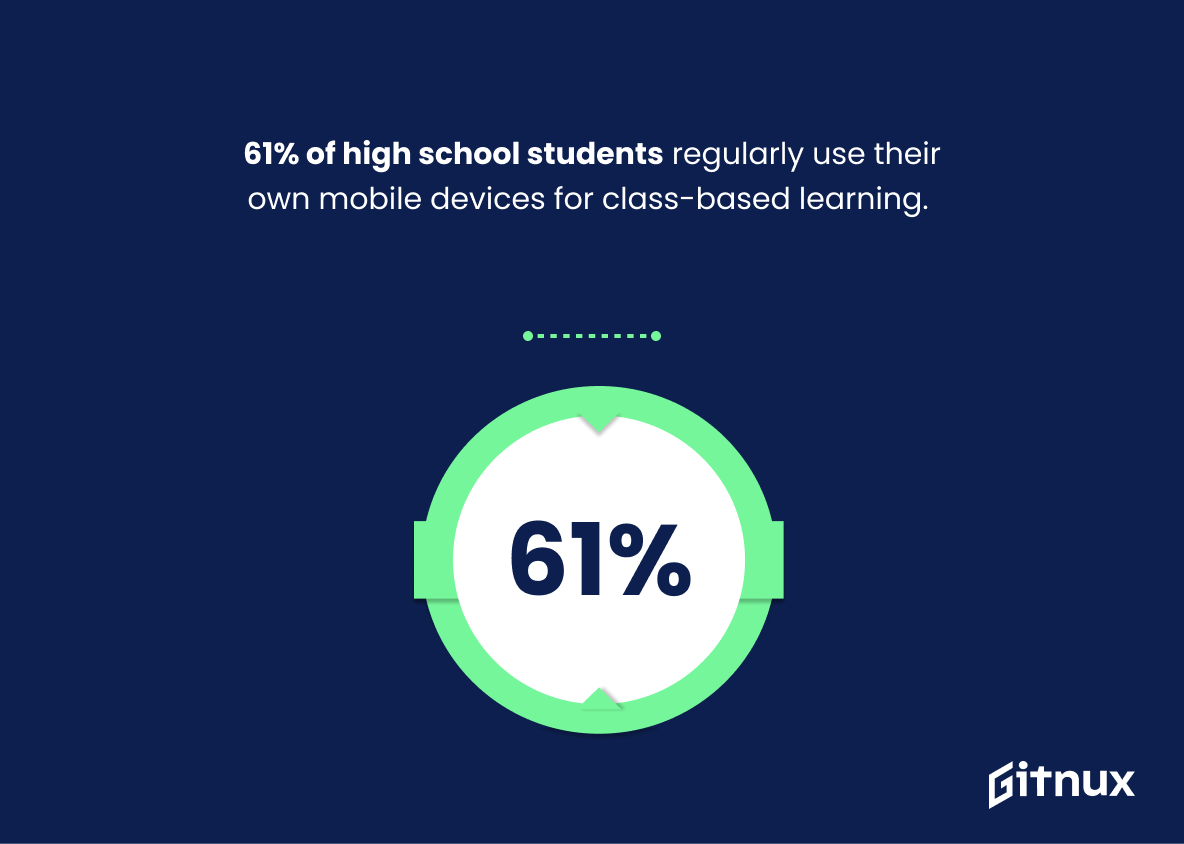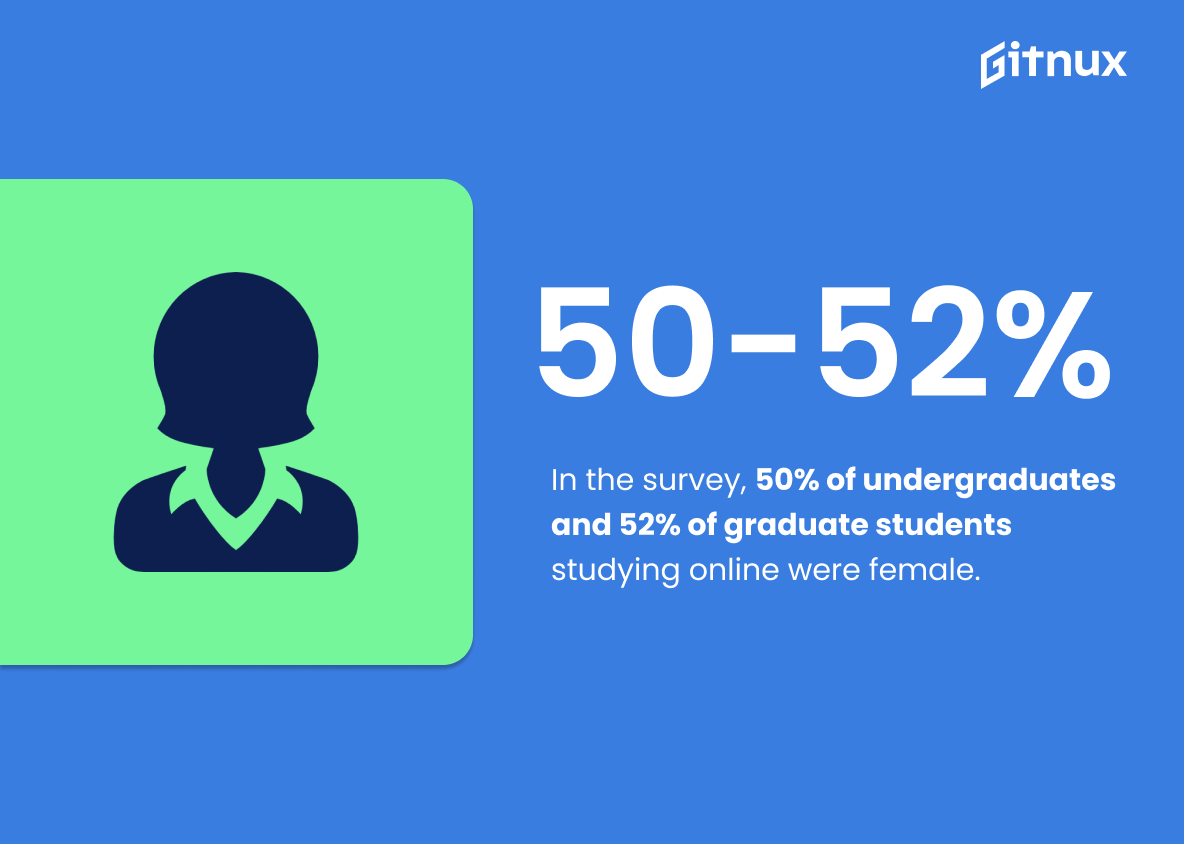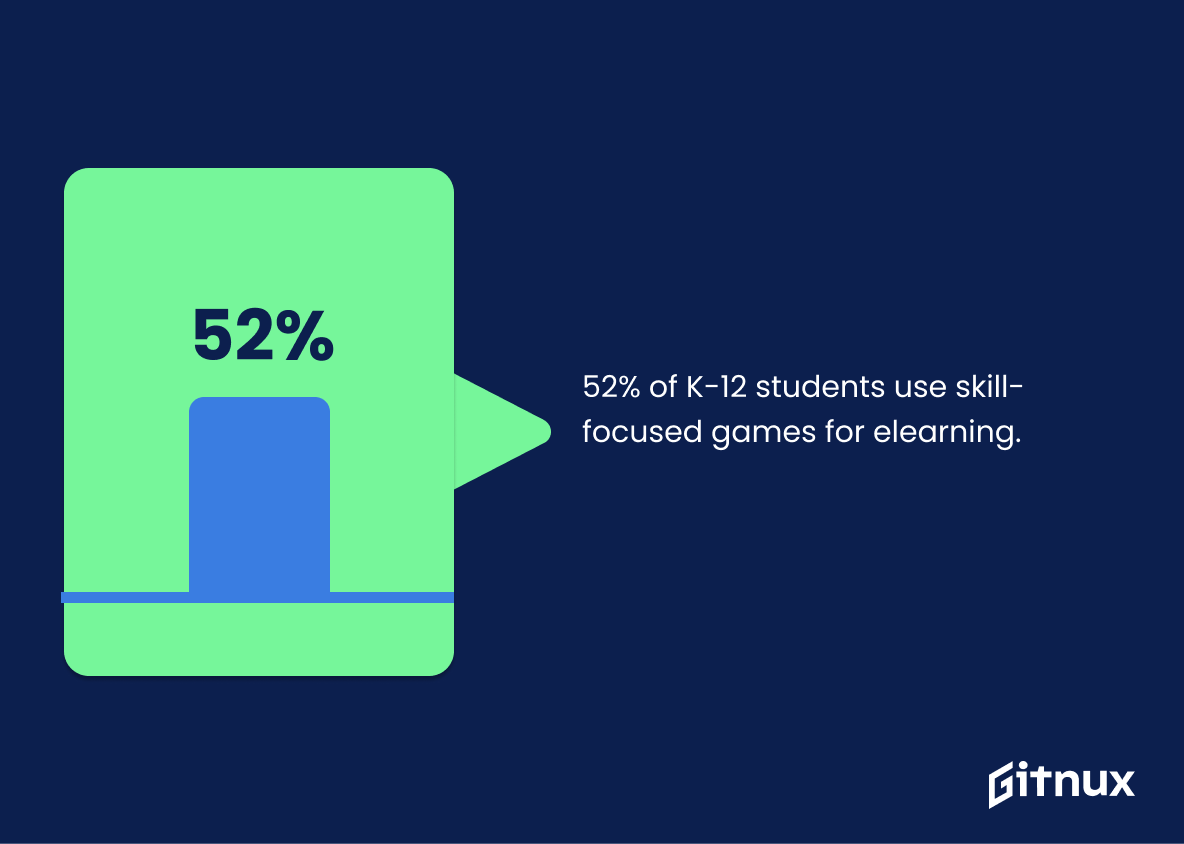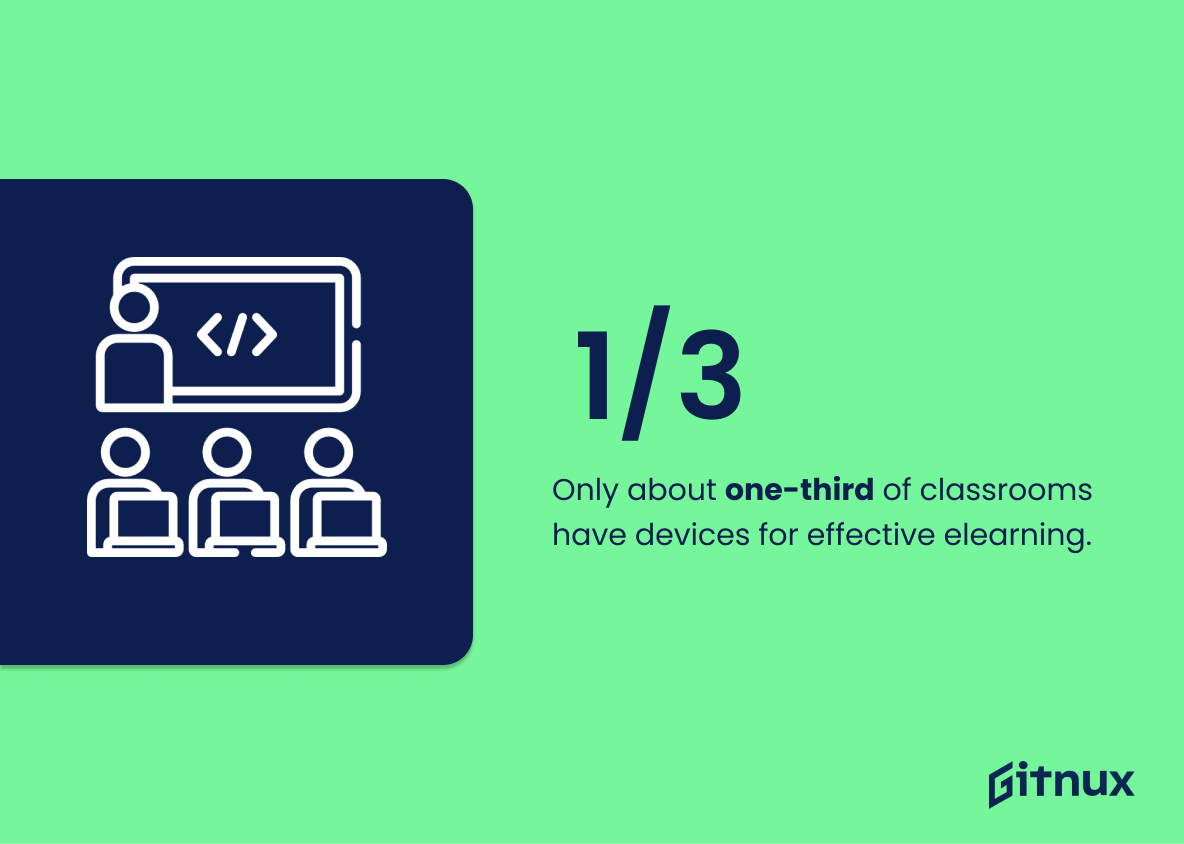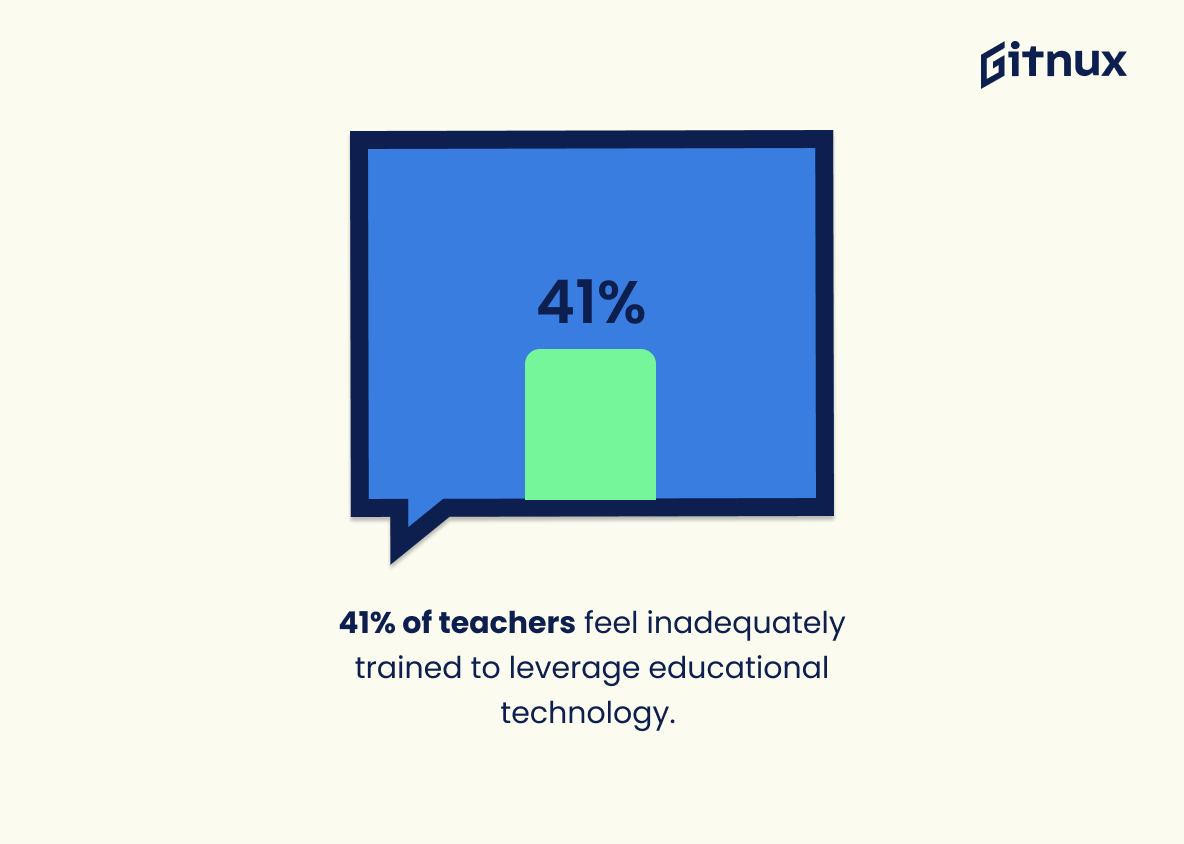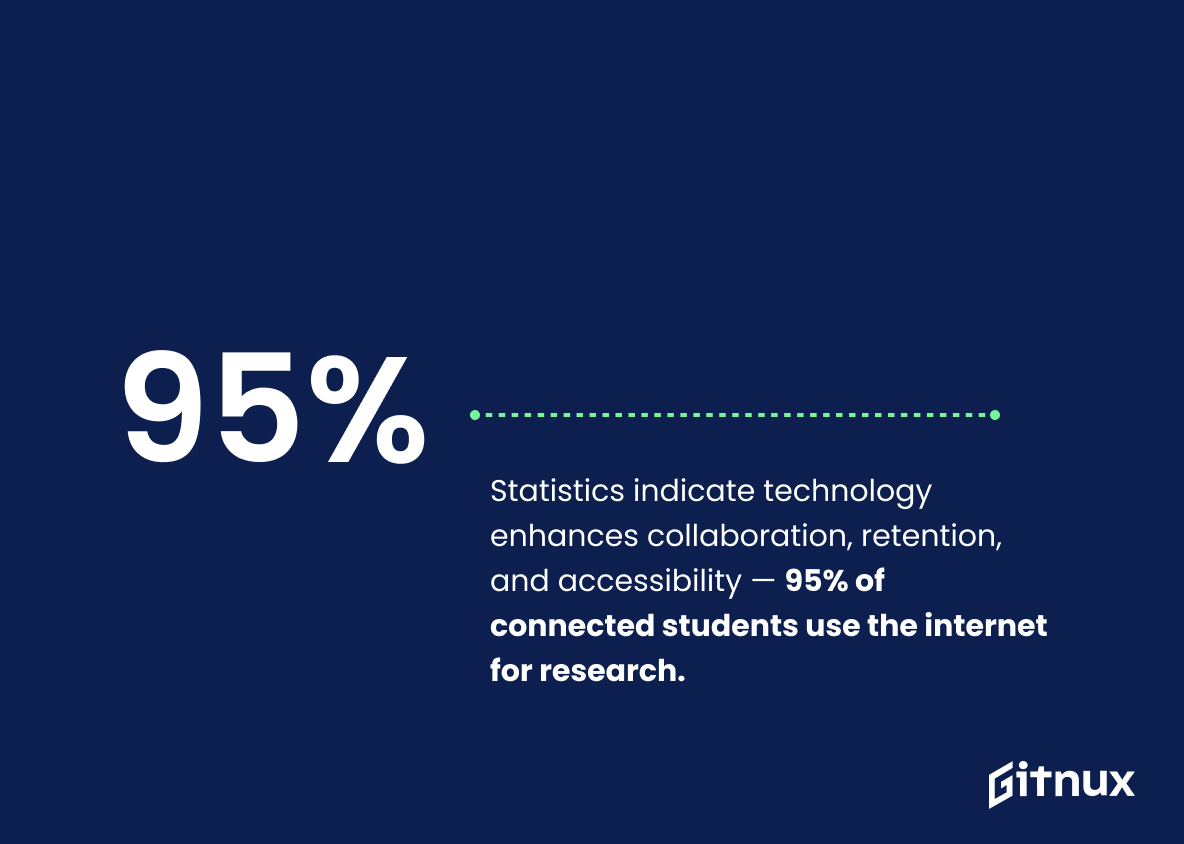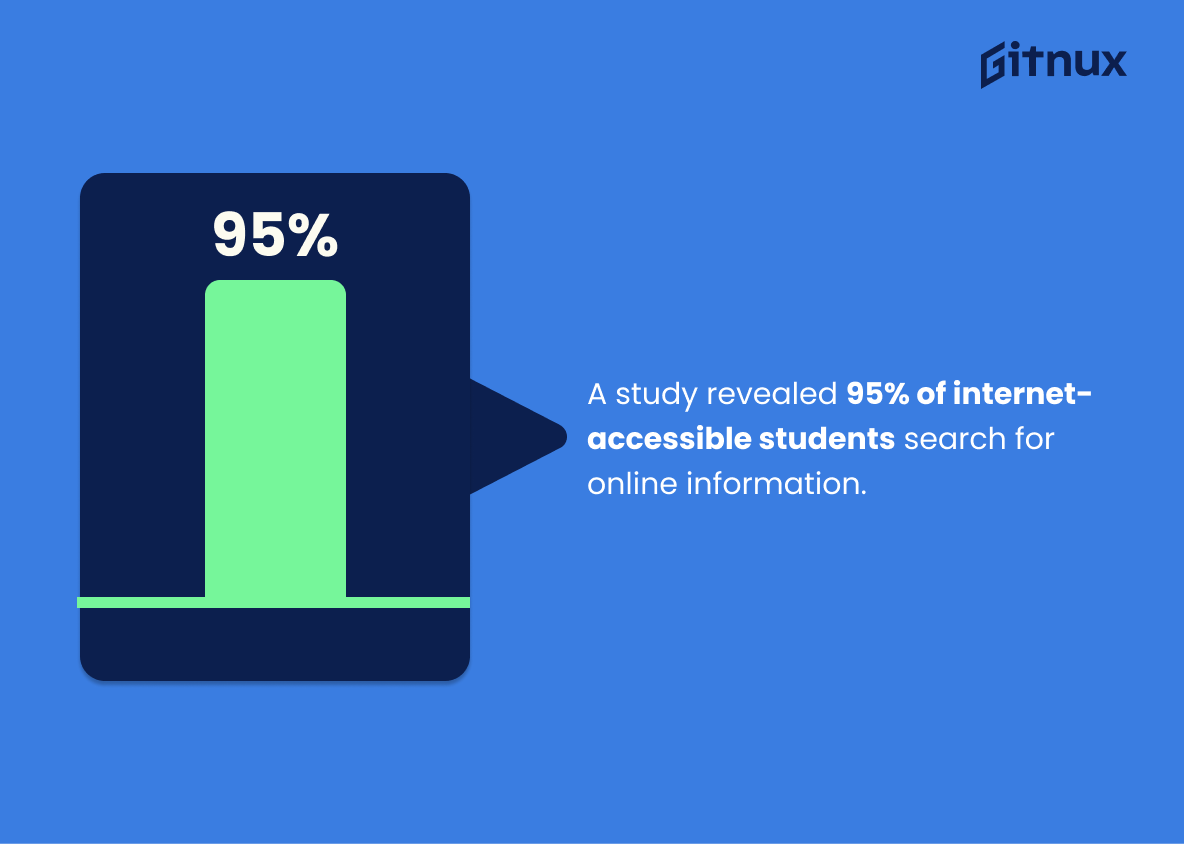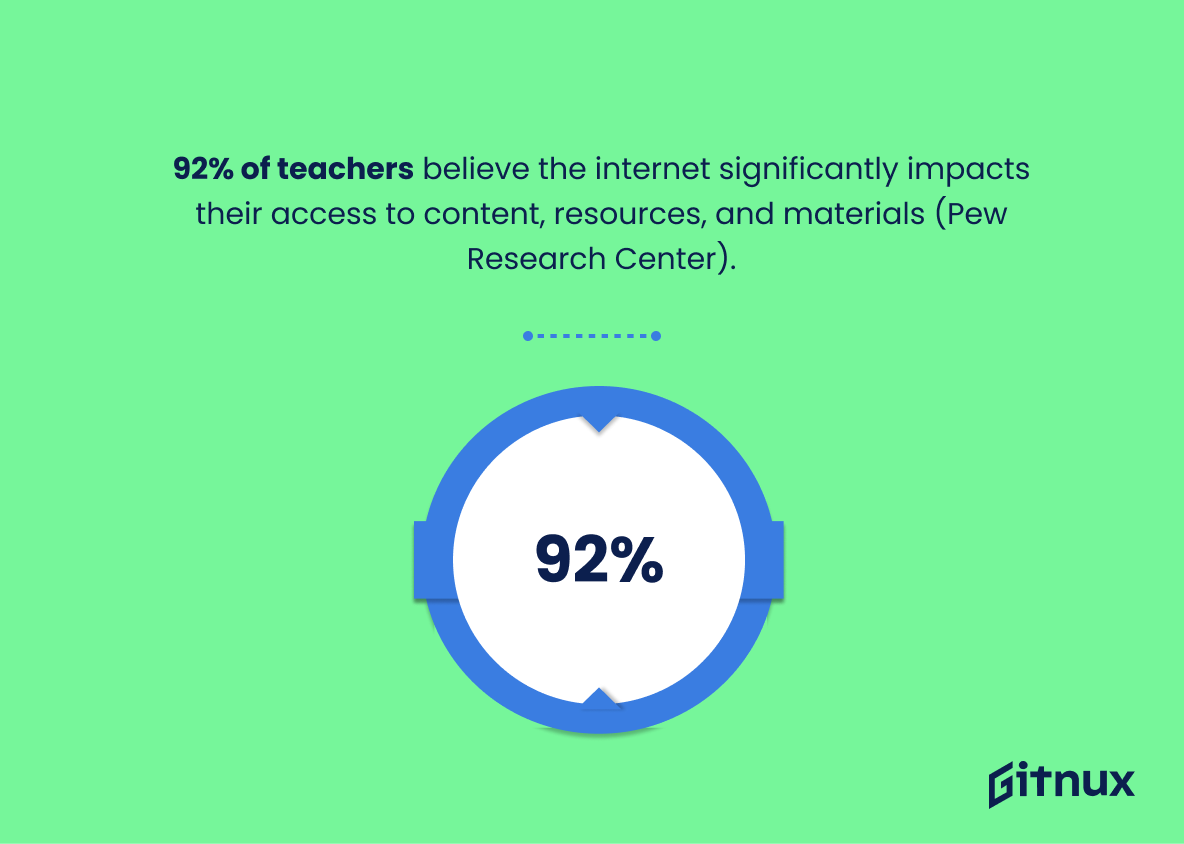Technology has revolutionized the way we learn and teach. It has become an integral part of the classroom, with many schools now investing in the latest gadgets and software to keep students engaged and motivated. But what does the data say about the use of technology in the classroom?
This blog post will explore the latest statistics on the use of technology in classrooms around the world, examining the trends and benefits of incorporating technology into the learning environment. From the impact of tablets and laptops to the rise of digital textbooks, this post will provide an in-depth look at the current state of technology in the classroom.
Technology In Classrooms: The Most Important Statistics
Elearning seems to be good for the environment as it cuts over 85% of carbon dioxide emissions.
As of April 2020, over 9 million children still did not have access to the internet from home.
General Statistics On Technology In Classrooms
Available technologies in the classroom: Personal computer or PC (90%), Interactive whiteboards (59%), Handhelds (including cell-phones, smartphones, iPods, etc.) (36%), Tablets/electronic readers (35%).
Most beneficial uses of tablets and e-readers for learning: educational applications (71%), educational websites (64%), and educational ebooks/textbooks (60%).
Students aged 11 to 18 use technology for around 7.5 hours a day.
In April 2020, 73% of households in the United States had permanent access to the internet for online learning. This statistic is only increasing over time.
The global education technology market could be worth $404 billion by the end of 2025. This is a steep increase from the global education technology market’s estimated valuation of $76.4 billion in 2019.
Digital Learning Tools In Classrooms Statistics
Skill-developing software tools and online videos are the most common examples of technology in the classroom.
In a 2019 survey, 23% of grade 6-12 students reported that their teacher spent all of the class using digital learning technologies to teach in science, math, and history/social studies.
When it comes to emerging technologies such as augmented reality, virtual reality or artificial intelligence, there is a lot of interest, but less than 10% of schools are actually using these tools in their learning environments.
61% of high school students are regularly using their own mobile devices to support class-based learning.
The majority of students (83%) say that they use G Suite for Education products to support schoolwork in grades 6-12.
High school students are using technology tools outside of school that support their academic interests. Some of those activities include reading news stories online (62%), tapping into social media channels to learn about what others are doing around a topic of interest (57%), playing online or digital games (42%), leveraging online writing tools to get feedback for self-improvement (42%) and watching TED Talks to learn about people’s ideas (41%).
Online Learning Statistics
Those aged 16 to 24 were the most likely to use online learning materials, while men were slightly more likely than women to use this method; those in the 25 to 34 age bracket were the most likely to have used an online course.
During the survey, 50% of undergraduate students and 52% of graduate students studying online were female.
Elearning seems to be good for the environment as it cuts over 85% of carbon dioxide emissions.
Studies suggest that elearning can lessen energy consumption by about 90%.
96% of students, especially children, say that elearning tools are fun to use and help them learn things on their own.
90% of K-12 public school teachers claim that digital learning tools are the best when searching for information or doing research.
57% of all K-12 students in the U.S. are using digital learning tools for their daily education in 2019.
52% of K-12 students take advantage of games that focus on specific skills or content for their elearning materials.
In the fall of 2018, there are about 6.9 million college students enrolled in distance education courses.
60% of undergraduates choose an online education program based on its affordability. However, 39% of them think that the reputation of the program or school is the number one deciding factor.
There are currently 110 million students enrolled in MOOC programs.
Only about one-third of the classrooms are equipped with devices for effective elearning courses.
45% of students think that their Wi-Fi connections are too slow for the digital learning system.
41% of teachers believe they are not well-trained enough to effectively leverage educational technology.
39% of the teachers in English Maintained Schools are not willing to support elearning tools in their teaching.
What Are The Benefits Of Technology In Classrooms?
Technology puts students at the center of learning, and the benefits are clear. Let’s have a look at a few interesting statistics.
According to statistics gathered for a recent NUITEQ infographic, the use of technology can not only boost collaboration opportunities and student retention but also make information more accessible — 95% of students with connectivity use the internet for research.
Although many educators recognize the power of classroom technologies, some schools lack the infrastructure that is necessary to support technology-enhanced learning. According to an infographic, 80% of schools have insufficient internet access.
15% of teachers of students who are from upper-income households say their school is “behind the curve”. And, 39% of teachers of students who are from lower-income households say their school is “behind the curve”.
16 out of 18 students remembered more facts about the animal after completing the presentation. These results show that technology indeed helps students remember what they learn.
A study revealed that 95% of the students who have access to the internet use it to search for online information.
Over 39% of students having access to the internet use it to participate in online discussions. And around 40% of them develop, share, or post their work on a website, wiki, or blog via the internet.
According to the Pew Research Center, 92% of teachers said that the internet has a major impact on their ability to access content, resources, and materials.
For example, 84% of teachers report using the internet at least weekly to find content that will engage students.
What Are The Drawbacks Of Technology In Classrooms?
Various studies have shown that the use of technology does not necessarily improve the performance or learning skills of students. There have been signs of negative impacts on writing skills amongst students using digital tools, as they have a tendency to write fast and carelessly, using more and more abbreviations in their writings than they would when communicating electronically.
In the US in 2015 more than 80% of 8th graders say they use computers at home for schoolwork.
A Canadian institute showed that 51% of high school students in a survey acknowledged having cheated during exams, and that technology had its part to play by making it easier to cheat.
76% of teachers said that students are being conditioned by the internet to find quick answers, which leads to a loss of concentration.
60% of teachers said that technology is hindering the way students communicate face-to-face.
As of April 2020, over 9 million children still did not have access to the internet from home.
Schools were asked about the challenges their teachers face in using technology for teaching purposes. 22% of them said that outdated computers or software was a moderate challenge. Another 12% said that was a large challenge. 26% of schools said that lack of support on how to use technology for teaching was a moderate challenge, and another 8% said it was a large challenge.
The majority of respondents considered their online education to be boring, while the other 10% characterized digital education as tiring, stressful, of poor quality, or exhausting.
Supplementary Statistics
92% of teachers claim that technology has a major impact on the classroom experience, improving the way they can reach their students.
The majority of teachers recognize the potential of technology to enhance the learning experience, and that they are actively utilizing it to reach their students. This statistic is a testament to the fact that technology is becoming an increasingly integral part of the educational process, and that it is having a positive impact on the classroom experience.
96% of educators believe that technology increases student engagement in learning.
Educators are recognizing the value of technology in engaging students in the learning process, and that they are increasingly turning to technology to help them achieve their educational goals. This statistic is a testament to the fact that technology is becoming an increasingly important part of the classroom, and that educators are embracing its potential to enhance student engagement.
Approximately 75% of educators believe that digital media provides a more personalized learning experience.
Educators are embracing the use of technology in the classroom and are recognizing the benefits it can bring to students. This is an important statistic to consider when discussing the use of technology in classrooms, as it demonstrates that educators are open to the idea of using technology to enhance the learning experience.
85% of teachers believe that technology usage positively impacts the quality of their lessons.
The majority of teachers recognize the value of technology in their teaching, and that it has had a positive effect on the quality of their lessons. This statistic is important to consider when discussing the use of technology in classrooms, as it demonstrates the potential benefits of incorporating technology into the classroom.
82% of parents support the increased use of technology in the classroom.
This demonstrates the widespread approval of the use of technology in the classroom. It shows that the majority of parents are in favor of the increased use of technology in the classroom, which is a strong indication that technology can be a beneficial tool for students.
In 2019, 48 U.S. states had K-12 computer science standards in place.
The majority of states in the US have recognized the need to equip students with the skills and knowledge to use technology effectively. This is a positive step towards preparing students for the digital world they will enter after graduation.
The projected spending on education technology is expected to reach $342 billion by 2025.
Education institutions are investing heavily in technology, which suggests that they are recognizing the potential of technology to improve the learning experience. This is an encouraging sign for those who are advocating for the use of technology in the classroom, as it shows that the trend is moving in the right direction.
81% of teachers agree that digital textbooks help students learn more in less time.
The majority of teachers believe that digital textbooks can help students learn more in less time, which is a huge benefit for students and teachers alike. This statistic is an important piece of evidence that technology can be used to improve the learning experience in the classroom.
On average, students with access to technology score 15 points higher on tests than their peers without access.
Students with access to technology are able to perform better on tests than those without access, indicating that technology can be a powerful tool for learning. This highlights the need for schools to invest in technology and ensure that all students have access to the same resources.
Teachers who use technology in the classroom are twice as likely to receive training on how to integrate technology into a lesson plan.
Teachers are taking the initiative to learn how to use technology to enhance their lessons, and that they are being provided with the necessary training to do so. This indicates that schools are recognizing the value of technology in the classroom and are taking steps to ensure that their teachers are equipped with the skills to use it effectively. This is an encouraging sign for the future of technology in the classroom, and it is a statistic that should not be overlooked.
Only 43% of teachers are provided with technology training workshops by their schools.
Many teachers are not being given the opportunity to learn how to use technology in the classroom, which could be hindering their ability to effectively teach students. It is essential that teachers are given the resources and training they need to be able to use technology in the classroom, as it can be a powerful tool for learning.
90% of teachers believe that technology enables them to complement and expand on the lessons they teach.
Teachers recognize the potential of technology to enhance their lessons and provide students with a more comprehensive learning experience. This is an important point to make in a blog post about technology in classrooms, as it demonstrates that teachers are embracing the use of technology in their classrooms and are finding it to be a valuable tool.
In 2018, the percentage of U.S. public schools with a computer for every student reached 61%.
More and more schools are recognizing the need to provide students with access to computers, which can help them stay up to date with the latest technology and prepare them for the future.
Conclusion
Technology in classrooms has become increasingly popular in recent years, with many schools investing in the latest technology to enhance their students’ education. The statistics show that technology can be a great asset to the classroom, with students showing improved engagement, better grades, and increased creativity.
With the right implementation, technology can be a powerful tool to help students learn and grow. Therefore, it is important for schools to consider the potential of technology in the classroom and make sure they are using it in the most effective way possible.
Check out our latest Technology In Education Statistics
References:
Statista: “Usage of digital learning tools by grade 6-12 teachers for teaching in the United States in 2019, by subject”, cited in [Current Month] 2023 (Source)
TheJournal: “How Teachers Use Technology to Enrich Learning Experiences”, cited in [Current Month] 2023 (Source)
Statista: “Share of students studying online in the United States in 2020, by gender and education level”, cited in [Current Month] 2023 (Source)
Research.com: “66 Elearning Statistics: 2023 Data, Analysis & Predictions”, cited in [Current Month] 2023 (Source)
EdTech: “6 Ways Students Benefit from Technology Integration [#Infographic]”, cited in [Current Month] 2023 (Source)
WaldenUniversity: “Top 5 Benefits of Technology in the Classroom”, cited in [Current Month] 2023 (Source)
Library New Acropolis: “The Negative Impact of Technology on Education”, cited in [Current Month] 2023 (Source)
Weebly: “Technology in Schools”, cited in [Current Month] 2023 (Source)
Linkedin: “A Comprehensive Look at the Statistics on Technology Use in Learning & Development and The Ultimate L&D Strategy for Your Institution”, cited in [Current Month] 2023 (Source)
IES: “Use of Educational Technology for Instruction in Public Schools:
2019—20”, cited in [Current Month] 2023 (Source)
Statista: “How would you describe your online classes?”, cited in [Current Month] 2023 (Source)
ZipDo, cited June 2023: Technology In Classrooms Statistics
